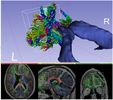Difference between revisions of "Documentation/Nightly/Modules/DiffusionTensorScalarMeasurements"
From Slicer Wiki
| Line 65: | Line 65: | ||
<!-- ---------------------------- --> | <!-- ---------------------------- --> | ||
{{documentation/{{documentation/version}}/module-section|References}} | {{documentation/{{documentation/version}}/module-section|References}} | ||
| + | * [http://www.ncbi.nlm.nih.gov/pubmed/8130344 Basser, 1994] | ||
| + | * [http://www.ncbi.nlm.nih.gov/pubmed/12044998 Westin, 2002] | ||
| + | * [http://www.ncbi.nlm.nih.gov/pubmed/16342267 Ennis & Kindlmann, 2006] | ||
* http://slicerdmri.github.io/ | * http://slicerdmri.github.io/ | ||
Revision as of 13:59, 7 September 2016
Home < Documentation < Nightly < Modules < DiffusionTensorScalarMeasurements
|
For the latest Slicer documentation, visit the read-the-docs. |
Introduction and Acknowledgements
|
| |||||||||||
|
Module Description
Compute scalar measures from a diffusion tensor dataset. Available measurements include fractional anisotropy, trace, and more.
Use Cases
Most frequently used for these scenarios:
- Use Case 1: Create FA (fractional anisotropy image)
- Use Case 2: Quantify FA or another measure in a region of interest (using also the Editor and Quantification->Label Statistics)
Tutorials
Links to tutorials that use this module
- Slicer4 Diffusion Tensor Imaging Tutorial: https://www.slicer.org/slicerWiki/index.php/Documentation/Nightly/Training#Slicer4_Diffusion_Tensor_Imaging_Tutorial
Panels and their use
Parameters:
- Settings: Input/output parameters
- Input DTI Volume (inputVolume): Input DTI volume
- Output Volume (outputScalar): Scalar volume derived from tensor
- Scalar Measurement (operation): Type of scalar measurement to perform
List of parameters generated transforming this XML file using this XSL file. To update the URL of the XML file, edit this page.
- Trace: trace of the diffusion tensor (equal to the sum of its eigenvalues). Trace = 3 * MD, where MD is mean diffusivity.
- Determinant: determinant of diffusion tensor.
- RelativeAnisotropy: ratio of the anisotropic part of the diffusion tensor to the isotropic part (Basser, 1994)
- FractionalAnisotropy: the degree of anisotropy of diffusion (Between 0 and 1 where 0 = completely isotropic, 1 = completely anisotropic). This measure can be thought of as quantifying how far the shape of diffusion is from a sphere.
- Mode: Quantifies how linear or planar the diffusion is (cigar vs. pancake shape). FA and mode are orthogonal measures. (Ennis & Kindlmann, 2006).
- LinearMeasure: is high in "cigar-shape" tensors, where the first eigenvalue is much larger than the others (Westin, 2002).
- PlanarMeasure: is high in "pancake-shape" planar tensors, where the smallest eigenvalue is much less than the others (Westin, 2002).
- SphericalMeasure: is high where all three eigenvalues are equal, giving a "sphere-shape" of the tensor (Westin, 2002).
- MinEigenvalue: the smallest of the three eigenvalues of the diffusion tensor (also called lambda 3).
- MidEigenvalue: the second smallest eigenvalue of the diffusion tensor (also called lambda 2).
- MaxEigenvalue: the largest of the three eigenvalues of the diffusion tensor (also called lambda 1).
- ParallelDiffusivity: this is equal to the first eigenvalue, lambda 1.
- PerpendicularDiffusivity: this is the average of the smaller two eigenvalues, lambda 2 and lambda 3.
Similar Modules
- DWIToDTIEstimation
- FiberTractMeasurements




